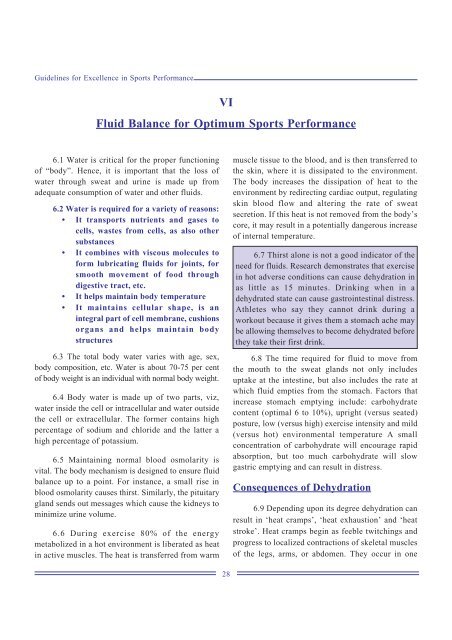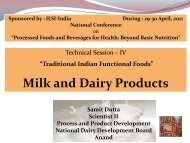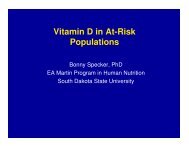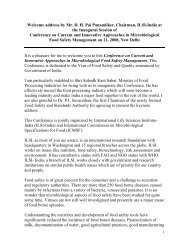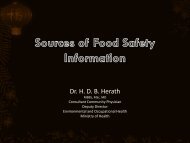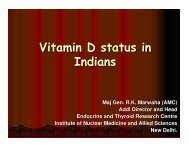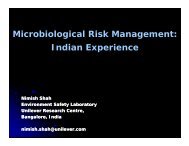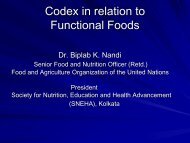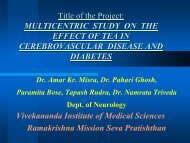Nutrition and Hydration Guidelines for Excellence in Sports - ILSI India
Nutrition and Hydration Guidelines for Excellence in Sports - ILSI India
Nutrition and Hydration Guidelines for Excellence in Sports - ILSI India
Create successful ePaper yourself
Turn your PDF publications into a flip-book with our unique Google optimized e-Paper software.
<strong>Guidel<strong>in</strong>es</strong> <strong>for</strong> <strong>Excellence</strong> <strong>in</strong> <strong>Sports</strong> Per<strong>for</strong>mance<br />
VI<br />
Fluid Balance <strong>for</strong> Optimum <strong>Sports</strong> Per<strong>for</strong>mance<br />
6.1 Water is critical <strong>for</strong> the proper function<strong>in</strong>g<br />
of “body”. Hence, it is important that the loss of<br />
water through sweat <strong>and</strong> ur<strong>in</strong>e is made up from<br />
adequate consumption of water <strong>and</strong> other fluids.<br />
6.2 Water is required <strong>for</strong> a variety of reasons:<br />
• It transports nutrients <strong>and</strong> gases to<br />
cells, wastes from cells, as also other<br />
substances<br />
• It comb<strong>in</strong>es with viscous molecules to<br />
<strong>for</strong>m lubricat<strong>in</strong>g fluids <strong>for</strong> jo<strong>in</strong>ts, <strong>for</strong><br />
smooth movement of food through<br />
digestive tract, etc.<br />
• It helps ma<strong>in</strong>ta<strong>in</strong> body temperature<br />
• It ma<strong>in</strong>ta<strong>in</strong>s cellular shape, is an<br />
<strong>in</strong>tegral part of cell membrane, cushions<br />
organs <strong>and</strong> helps ma<strong>in</strong>ta<strong>in</strong> body<br />
structures<br />
6.3 The total body water varies with age, sex,<br />
body composition, etc. Water is about 70-75 per cent<br />
of body weight is an <strong>in</strong>dividual with normal body weight.<br />
6.4 Body water is made up of two parts, viz,<br />
water <strong>in</strong>side the cell or <strong>in</strong>tracellular <strong>and</strong> water outside<br />
the cell or extracellular. The <strong>for</strong>mer conta<strong>in</strong>s high<br />
percentage of sodium <strong>and</strong> chloride <strong>and</strong> the latter a<br />
high percentage of potassium.<br />
6.5 Ma<strong>in</strong>ta<strong>in</strong><strong>in</strong>g normal blood osmolarity is<br />
vital. The body mechanism is designed to ensure fluid<br />
balance up to a po<strong>in</strong>t. For <strong>in</strong>stance, a small rise <strong>in</strong><br />
blood osmolarity causes thirst. Similarly, the pituitary<br />
gl<strong>and</strong> sends out messages which cause the kidneys to<br />
m<strong>in</strong>imize ur<strong>in</strong>e volume.<br />
6.6 Dur<strong>in</strong>g exercise 80% of the energy<br />
metabolized <strong>in</strong> a hot environment is liberated as heat<br />
<strong>in</strong> active muscles. The heat is transferred from warm<br />
muscle tissue to the blood, <strong>and</strong> is then transferred to<br />
the sk<strong>in</strong>, where it is dissipated to the environment.<br />
The body <strong>in</strong>creases the dissipation of heat to the<br />
environment by redirect<strong>in</strong>g cardiac output, regulat<strong>in</strong>g<br />
sk<strong>in</strong> blood flow <strong>and</strong> alter<strong>in</strong>g the rate of sweat<br />
secretion. If this heat is not removed from the body’s<br />
core, it may result <strong>in</strong> a potentially dangerous <strong>in</strong>crease<br />
of <strong>in</strong>ternal temperature.<br />
6.7 Thirst alone is not a good <strong>in</strong>dicator of the<br />
need <strong>for</strong> fluids. Research demonstrates that exercise<br />
<strong>in</strong> hot adverse conditions can cause dehydration <strong>in</strong><br />
as little as 15 m<strong>in</strong>utes. Dr<strong>in</strong>k<strong>in</strong>g when <strong>in</strong> a<br />
dehydrated state can cause gastro<strong>in</strong>test<strong>in</strong>al distress.<br />
Athletes who say they cannot dr<strong>in</strong>k dur<strong>in</strong>g a<br />
workout because it gives them a stomach ache may<br />
be allow<strong>in</strong>g themselves to become dehydrated be<strong>for</strong>e<br />
they take their first dr<strong>in</strong>k.<br />
6.8 The time required <strong>for</strong> fluid to move from<br />
the mouth to the sweat gl<strong>and</strong>s not only <strong>in</strong>cludes<br />
uptake at the <strong>in</strong>test<strong>in</strong>e, but also <strong>in</strong>cludes the rate at<br />
which fluid empties from the stomach. Factors that<br />
<strong>in</strong>crease stomach empty<strong>in</strong>g <strong>in</strong>clude: carbohydrate<br />
content (optimal 6 to 10%), upright (versus seated)<br />
posture, low (versus high) exercise <strong>in</strong>tensity <strong>and</strong> mild<br />
(versus hot) environmental temperature A small<br />
concentration of carbohydrate will encourage rapid<br />
absorption, but too much carbohydrate will slow<br />
gastric empty<strong>in</strong>g <strong>and</strong> can result <strong>in</strong> distress.<br />
Consequences of Dehydration<br />
6.9 Depend<strong>in</strong>g upon its degree dehydration can<br />
result <strong>in</strong> ‘heat cramps’, ‘heat exhaustion’ <strong>and</strong> ‘heat<br />
stroke’. Heat cramps beg<strong>in</strong> as feeble twitch<strong>in</strong>gs <strong>and</strong><br />
progress to localized contractions of skeletal muscles<br />
of the legs, arms, or abdomen. They occur <strong>in</strong> one<br />
34 28


